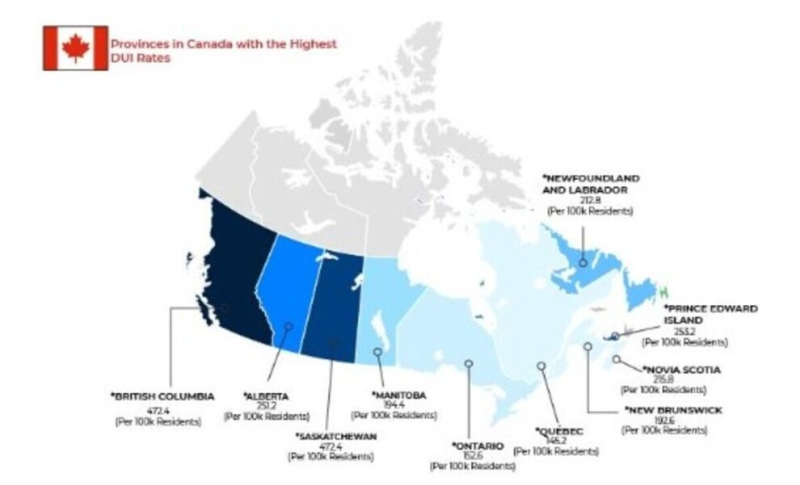- British Columbia leads the nation with 472.4 arrests per 100,000 residents.
- Saskatchewan and Prince Edward Island follow with 376 and 253.2 arrests per 100,000 residents, respectively.
- Quebec reported the lowest drunk driving arrest rate at 145.2 arrests per 100,000 residents.
A new study has revealed British Columbia leads the country with the highest drunk driving arrest rates per capita.
The study by personal injury lawyers at Preszler Law analyzed impaired driving data – both alcohol and drug-related – across Canada from 2017 to 2021 via Mothers Against Drunk Driving (MADD Canada). The total numbers were averaged and calculated per 100,000 residents to identify provinces with the highest and lowest drunk driving arrest rates in Canada.
British Columbia has the highest DUI (Driving Under the Influence) arrest rate in Canada with 472.4 arrests per 100,000 people. This is approximately 91.5% above the national average of 246.62. Between 2017 and 2021, the province recorded an average of 403.4 alcohol-related arrests per 100,000 people, complemented by 69.6 drug-related arrests per 100,000 people.
Saskatchewan ranks second with 376 arrests per 100,000 residents, standing about 52.4% above the national average of 246.62. Its five-year average from 2017 to 2021 shows 335.8 arrests for alcohol-related offenses and 40 arrests for drug-related offenses per 100,000 people.
In third place, Prince Edward Island records 253.2 arrests per 100,000 people, putting it at roughly 2.7% above the national average of 246.62. The province averages 226.2 alcohol-related arrests and 26.8 drug-related arrests per 100,000 residents between 2017 and 2021.
Alberta ranks fourth with 251.2 arrests per 100,000 residents, about 1.9% above the national average of 246.62. Between 2017 and 2021, it recorded 226.6 per 100,000 average for alcohol-related offenses and 24.6 per 100,000 for drug-related offenses.
In fifth place, Nova Scotia’s drunk driving arrest rate sits at 215.8 per 100,000 people, which is approximately 12.5% below the national average of 246.62. Its five-year averages for alcohol and drug-related arrests are 202.2 and 13.48 per 100,000 respectively.
Newfoundland and Labrador follows closely in sixth place at 212.8 arrests per 100,000 people, around 13.7% below the national average. The province’s five-year averages stand at 181.8 for alcohol-related arrests and 30.6 for drug-related arrests per 100,000 residents.
Manitoba ranks seventh with 194.4 drunk driving arrests per 100,000, putting it about 21.2% below the national average. Between 2017 and 2021, Manitoba recorded 183 arrests for alcohol-related offenses and 11.28 for drug-related offenses per 100,000 people.
New Brunswick ranks eighth with 192.6 arrests per 100,000 residents, 21.9% below the national average. The five-year data from 2017 to 2021 reveals 178.8 alcohol-related arrests and 13.76 drug-related arrests per 100,000 individuals.
In ninth place, Ontario records 152.6 arrests per 100,000, which is about 38.1% below the national average. The province’s five-year averages show 135.8 alcohol-related arrests and 16.44 drug-related arrests per 100,000 residents.
Quebec has the lowest drunk driving arrest rate among Canadian provinces, at 145.2 arrests per 100,000 people – 41.1% below the national average of 246.62. It also reflects a five-year average of 125.4 for alcohol-related arrests and 19.4 for drug-related arrests per 100,000.
Looking at the study, a spokesperson from Preszler Law said,
“This analysis exposes persistent gaps in road safety efforts, especially in provinces surpassing the national average. While Quebec is setting an example with its notably lower numbers, the statistics show no province is free from the burden of drunk driving.
Impaired drivers pose a serious threat on public roads, so other motorists are encouraged to stay vigilant and report any suspicious behavior to help prevent serious accidents.”
Table of Extended Results
| Provinces in Canada with the Highest DUI (Driving Under The Influence) Rates | ||||
| Rank | Province | 5 Year Average Alcohol (per 100k Residents) | 5 year Average Drugs (per 100k Residents) | 5-Year Average Total (Per 100k Residents) |
| 1 | British Columbia | 403.4 | 69.6 | 472.4 |
| 2 | Saskatchewan | 335.8 | 40 | 376 |
| 3 | Prince Edward Island | 226.2 | 26.8 | 253.2 |
| 4 | Alberta | 226.6 | 24.6 | 251.2 |
| 5 | Nova Scotia | 202.2 | 13.48 | 215.8 |
| 6 | Newfoundland and Labrador | 181.8 | 30.6 | 212.8 |
| 7 | Manitoba | 183 | 11.28 | 194.4 |
| 8 | New Brunswick | 178.8 | 13.76 | 192.6 |
| 9 | Ontario | 135.8 | 16.44 | 152.6 |
| 10 | Quebec | 125.4 | 19.4 | 145.2 |
The study was conducted by Preszler Law, a dedicated personal injury law firm, passionately advocating for plaintiffs’ rights and securing fair compensation nationwide.
ENDS
P.S. If using this story, please link and credit to www.preszlerlaw.com.
Methodology
- Impaired driving data from MADD Canada (2017–2021) was analyzed.
- All reported incidents of drunk driving (alcohol- and drug-related) were calculated per 100,000 residents across Canadian provinces.
- Annual figures were averaged over the five-year period (2017–2021) to determine the overall provincial rates.
Data Sources
MADD Canada DUI/Impaired Driving Data (2017–2021): https://madd.ca/pages/wp-content/uploads/2023/11/Impaired-Driving-Federal-Charges-and-Prov-Sanctions_2010-to-2021_MADD-Canada-2023.pdf?utm_source=chatgpt.com



